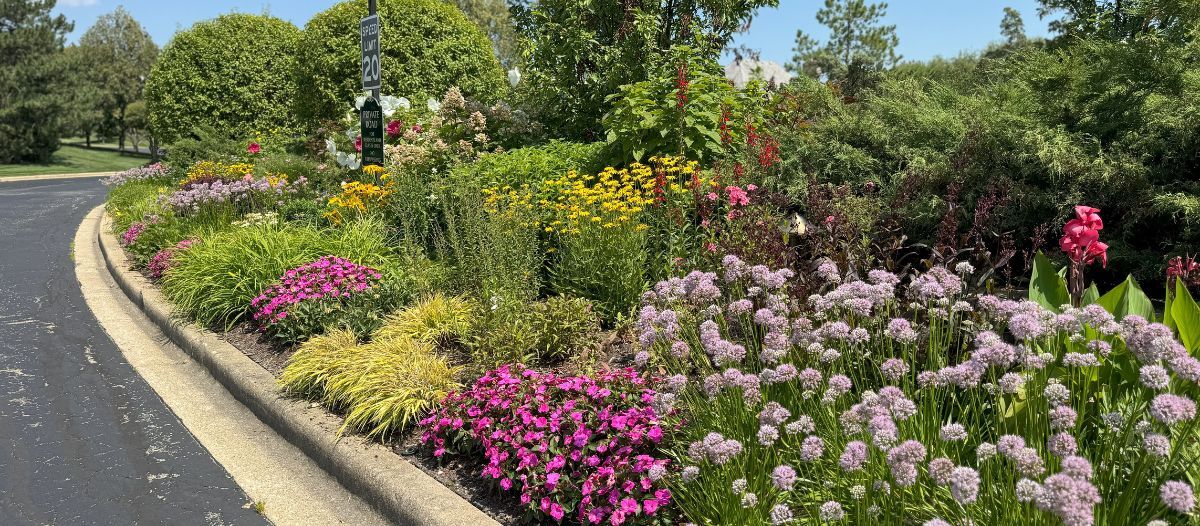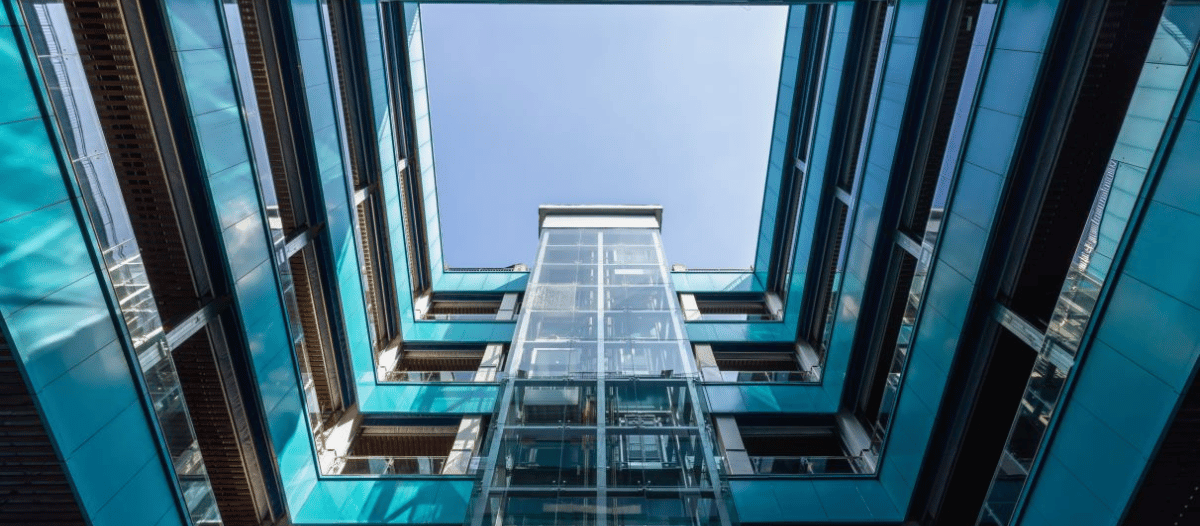Grounded in Strategy
A data-driven framework for sustainable landscapes

Sustainable landscaping may not warrant the same attention as other hallmarks of facility operations and maintenance, but it is important as it integrates environmental stewardship with strategic real estate enhancement to deliver ecological and economic benefits. By using appropriate native species, efficient water management and green infrastructure, these landscapes reduce resource consumption, cut operational expenses and support biodiversity.
Sustainable facility landscapes are carefully engineered outdoor environments that function as living extensions of the built asset, using ecological design principles to reduce resource inputs, manage stormwater and enhance the well-being of occupants and local wildlife.
At their core, these landscapes utilize green infrastructure, such as bioswales, permeable pavements and constructed wetlands, to mimic natural hydrological processes. This minimizes runoff and improves water quality. Native and drought-tolerant plantings are selected not only for aesthetic value but also for their ability to thrive with minimal irrigation and to support local pollinators and bird species according to World Landscape Architect.
Key components include green roofs that layer lightweight substrates and vegetation atop buildings to insulate interiors and capture rainfall; rain gardens and bioswales that channel and infiltrate stormwater; and permeable hardscapes that recharge groundwater while reducing surface flooding. These systems work in concert to cut potable water use by 50 percent or more while delivering thermal comfort gains and lowering energy loads through improved building envelope performance.
Example facility: The Bullitt Center
Seattle’s Bullitt Center, often hailed as “the greenest commercial building in the world,” exemplifies sustainability. It sources 100 percent of its water from rain harvested on a parapet roof, storing up to 56,000 gallons in a basement cistern and treating it to potable standard. The rooftop constructed wetland, planted with native equisetum and juncus species, cleanses greywater before it recharges the soil, effectively closing the loop on the building’s water cycle.
Bullitt Center FMs report this integrated approach not only eliminated municipal water costs but also reduced stormwater discharge to zero. These outcomes validate both the environmental stewardship and operational savings possible through sustainable facility landscapes.
FMs can follow this example by embedding sustainability into their long-term planning and budgeting outdoor space strategy. It is not only an environmental imperative but also a driver of property value, tenant satisfaction and regulatory compliance.
RFP development phase
Drafting sustainability‑centric RFPs
Begin by defining clear sustainability objectives. Some examples include reduced potable water use, stormwater management targets, and carbon footprint reductions. They can then be translated into measurable RFP requirements. Incorporate environmental, social and governance (ESG) scoring criteria aligned with recognized frameworks (e.g., LEED, BREEAM) to benchmark proposals against industry best practices.
Key evaluation metrics
Evaluate bids on factors including:
-
Water conservation potential (e.g., projected irrigation savings in gallons per year).
-
Stormwater infiltration capacity (e.g., permeable surface area, expected runoff reduction).
-
Native plant installation (percentage coverage and maintenance requirements).
-
Contractor sustainability performance, such as prior project case studies and carbon accounting.
Ensuring transparency & accountability
Require detailed life cycle cost analyses (LCCA) for major components and stipulate post‑project monitoring reports to verify outcomes. Embed performance‑based contract clauses that link payment milestones to demonstrable sustainability achievements. One example of this would be maintaining specified irrigation thresholds or achieving target runoff reductions.
Facility audit & assessment
Comprehensive facility audits
Conduct multilevel energy audits (Levels 1-3) to quantify baseline energy use across HVAC, lighting and plug loads. Level 2 audits typically cost US$0.10–$0.30 per sq. ft. and reveal savings of 10-40 percent on utility bills. Insulation upgrades coupled with air sealing can cut heating and cooling expenses by up to 20 percent according to Sustainable Energy Fund.
Landscape & water audits
Map existing irrigation systems, measure soil infiltration rates, and perform an inventory of plant species and canopy cover. Quantify current irrigation volumes, like a half‑acre turf lawn using approximately 162,924 gallons of water over a 12‑week summer period. Then model potential reductions with native plantings.
Data collection for cost & energy management
Leverage sub‑metering and building analytics platforms to capture real‑time energy and water use data. This continual monitoring informs targeted interventions, which can help with optimizing irrigation schedules based on weather data or adjusting HVAC setpoints by occupancy patterns.
Design & planning
Sustainable design principles
Adopting the triple-bottom-line approach balances environmental protection, social equity and economic value in landscape designs. Key principles include:
-
Native & drought‑tolerant plantings to minimize irrigation and support local wildlife.
-
Permeable pavements & bioswales that infiltrate stormwater, reduce flooding risk and filter pollutants.
-
Xeriscaping techniques in arid climates to cut outdoor water use by 60 percent or more.
-
Rain gardens & low‑impact development (LID) features that can hold up to 90 percent of runoff during major rain events.
Aligning design with long‑term goals
Translate audit findings into design targets like reducing potable water use by 50 percent within five years or achieving a BREEAM “Excellent” rating. Integrate maintenance considerations by selecting low‑maintenance species and modular hardscape elements to ensure sustainable performance with minimal ongoing costs.
Enhancing property value
Sustainable landscapes drive real estate premiums. According to a case study done by Sheffield Hallam University, BREEAM‑certified buildings command a 21 percent transaction price premium and an 18 percent rent premium over noncertified peers. Facility managers can justify upfront sustainability investments through enhanced asset valuation and tenant appeal.
Implementation & completion
Procurement & contractor selection
Select contractors with verifiable sustainability credentials and track records, such as prior LEED or Sustainable Sites Initiative projects (Sustainability.gov). Use a scoring matrix in the RFP that weighs sustainability performance at 30-40 percent of the overall score, alongside cost and schedule.
Quality assurance measures
Implement a detailed quality control (QC) checklist that covers planting, soil preparation, hardscape installation and irrigation system commissioning. Assign dedicated on‑site sustainability monitors to verify compliance with specifications at key milestones.
Post‑implementation review & monitoring
Within six months of project completion, conduct a follow‑up audit to compare actual performance of water use, energy consumption and runoff reduction. Compare that against design projections. Use IoT‑enabled sensors and software platforms to continuously monitor key metrics and flag deviations for corrective action.
Sustainable facility landscapes represent a strategic investment that simultaneously advances environmental stewardship, reduces operating costs and enhances real estate value. By adopting a structured approach, from sustainability‑focused RFPs and rigorous audits to data‑driven design, quality implementation and continuous monitoring, facility managers can achieve significant resource savings (up to 40 percent energy, 75 percent water) and secure measurable property premiums (18-21 percent).
Use third-party companies that exemplify these principles in action, delivering both ecological resilience and client satisfaction through eco‑smart materials and native plant selection.
Actionable recommendations
-
Embed sustainability metrics (water savings, runoff reduction, carbon footprint) into all RFPs and contracts.
-
Schedule annual Level 2 energy audits and seasonal landscape reviews to identify emerging inefficiencies.
-
Invest in green infrastructure (permeable pavements, rain gardens, native buffers) with documented payback analyses.
By following this framework, FMs can confidently integrate sustainable practices into their landscapes, driving long‑term value and resilience across diverse climatic and regulatory contexts.
Effective sustainable landscapes require proactive operations and maintenance (O&M). Routine upkeep mirrors traditional groundskeeping like removing trash and debris, inspecting vegetated areas and clearing sediment to sustain long-term performance of bioswales, rain gardens and permeable pavements. Establishing a detailed O&M plan with defined inspection intervals ensures that features such as tree box filters and green roofs remain fully functional well beyond installation.
Green infrastructure practices must be integrated into facility asset registers and turnover documents, guaranteeing continuity when ownership or management transitions occur. Specialized equipment such as vacuum-powered street sweepers for permeable pavements and cistern maintenance tools for rainwater harvesting systems should be identified, procured and budgeted appropriately.
Regular pruning and mulch replacement for tree box filters can sustain pollutant removal rates of 80-90 percent of total suspended solids (TSS) and 50-80 percent of phosphorus, aligning ongoing performance with original design intent.
A Wisconsin Sea Grant study of 22 green infrastructure installations found that inconsistent maintenance leads to clogged inlets and diminished functionality, underscoring the need for trained staff and clear standard operating procedures (SOPs).
FMs should adopt a performance-based monitoring regime using key performance indicators (KPIs) such as inches of runoff captured, gallons of potable water offset and reductions in pollutant loads. Data from continuous monitoring via simple flow meters, moisture sensors or smart cistern gauges should be reviewed quarterly to detect early signs of sediment buildup, vegetation stress or system blockages, allowing for timely, targeted interventions.
Collaboration with external partners like municipal stormwater agencies, local universities and environmental NGOs, provides access to technical assistance, research insights and even potential grant funding programs. Engaging building occupants and the broader community through interpretive signage, site tours and interactive dashboards fosters stewardship, gathers valuable user feedback and reinforces the behavioral aspects of sustainability.
By embedding these continuous improvement strategies of rigorous O&M, data-driven KPIs, specialized equipment planning and stakeholder engagement, FM professionals will ensure that their sustainable landscapes continue to deliver ecological benefits, operational savings and enhanced property value throughout every phase of the landscape’s life cycle.

Read more on Project Management and Operations & Maintenance or related topics Sustainable Facility , Facility Improvement and Operations and Maintenance Planning
Explore All FMJ Topics









